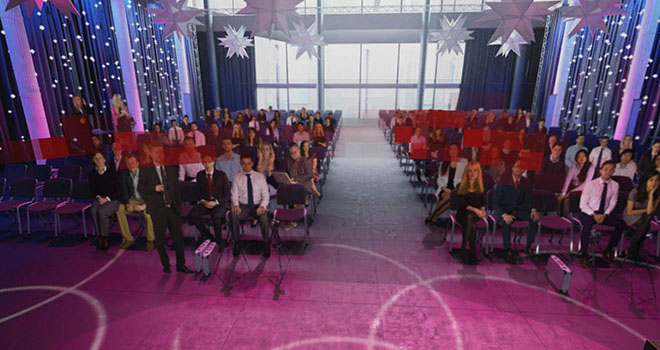8 Elements of Confident Body Language
August 10, 2017 - Sophie Thompson
If you want to find the truth, do not listen to the words coming to you. Rather see the body language of the speaker. It speaks the facts not audible. - Bhavesh Chhatbar
When you speak, you don't just speak with what you actually say, you also speak with your body language. From your facial expressions, to your posture and eye contact, they all add up to the 'truth' behind what you are saying. If you're feeling nervous, your body could be giving a different message to your audience than the one you're saying.
Body language is an essential part of public speaking success. Your non-verbal cues will impact on the way your message is received, how engaged your audience is, and what they think of you as an individual. Even if you've prepared the best speech in the world, if you aren't animated, open or active then your audience won't know what you've said.

Working on your body language can make a big difference to how you come across to your audience, and how you feel about public speaking in general. We've put together 8 of the most important elements of your body language that will shape how successful your speech is, explaining why they're important and how you can use them to your advantage.
1. Power pose
Why? In 2011, US social psychologists Amy Cuddy, Dana Carney and Andy Yap proposed that holding a 'power pose' resulted in people actually feeling more powerful.
Their theory suggests that an open pose can raise testosterone levels and lower your cortisol levels - ie. increase your dominance and lower your stress. If you have confident body language and pretend you feel powerful, you're more likely to actually feel it! And, who doesn't want to feel powerful on stage?
How:
- Stand straight with your shoulders back and feet shoulder width apart.
- Imagine your shoulders opening up from one another so that they rest centrally.
- Place your hands either side of your body so that you can easily make hand gestures when you need to.
- Face the audience as much as possible. If you're in a large room, tilt your whole body towards different parts of the audience so everyone feels included.

Amy Cuddy demonstrates a power pose — spreading your arms wide to appear more powerful. Image from TED.
Note: Issues with replicating this theory
There has been some debate recently as to whether power posing is actually effective. Read more here: Power posing replication failure
2. Eye contact
Why? Making eye contact with your audience builds a connection between you and them and they feel more valued by you. This makes the audience more likely to respect and listen to you because they feel important. It also makes the audience trust you more because people tend to avoid eye contact when they're lying.
Confident body language can also be used as a feedback loop. Making eye contact is the easiest to way to receive feedback from the audience about your speech.
You can see if your audience are listening and read their facial expressions to see if they are interested, bored, angry, happy, and so on. You can then alter your speech accordingly based on the feedback you see. Without making eye contact, you could go through your whole speech irritating the audience!
How:
- When talking to a large number of people, maintain eye contact with one audience member for 4 or more seconds before moving to another member of the audience for 4 seconds, and so on.
- Make eye contact in a 'Z' formation - look at one person at the back left corner of the room, then the back right, then to the front left, and finally to someone at the front right. Be careful not to just repeat the Z formation with the same audience members each time you do it - you want to connect with as many members of the audience as possible.
- In one-on-one settings, maintain eye contact for 9-10 seconds and then break away to save yourself from coming across as intense or like you're starting. (The same applies when answering a question from an audience of any size.)

Practice your eye contact in the virtual world with VirtualSpeech. A heatmap shows you where you were looking.
3. Hand gestures
Why? When used correctly, hand and arm gestures can help enhance your message and make you seem more confident and relaxed. Gestures amplify your stories and will help you come across as more genuine and believable. They're an essential element of our non-verbal communication in showing others how we feel, and in turn how we make them feel.
Hand gestures are one of the most clear non-verbal ways we communicate confident body language or nervous body language - and your audience will react more positively to the former.
How:
- Think of your hand gestures as a storytelling tool; put verbs into action by acting them out with your hands.
- Don't overdo it - gesture sparingly, and focus on action words. Make your gestures strong and defined.
- Begin in a neutral position with your hands either side of your body so that your hand gestures flow smoothly.
- Use symbolic gestures to communicate numbers and position, eg. 2 fingers for the number 2 and a raised hand for stop.
- Use descriptive gestures to communicate movement, eg. shapes, size, length, etc.
- Use emotional gestures to communicate feelings, eg. hands clasped together to show pleading, hands raise either side of your head to show despair.
- When using visual aids, point and turn slightly to look at the relevant data, and the audience will automatically follow your hands and eyes.
- Vary your gestures with different parts of your body. You don't have to just use your arms- you could use your legs, facial expressions and full body movement as gestures too.
Learn how to use body language to improve your professional relationships. Practice what you learn in virtual reality exercises. Learn more about the body language course.
4. Movement
Why? Moving around the stage is a great way of showing your audience you are confident in what you're saying and including everyone in the conversation. Commanding the space around you shows strong leadership and, after all, when you're presenting you are the leader.
When you have confident body language, you'll be more dynamic and interesting to listen to and your audience will not only be more engaged but they will have more trust in your message too.
How:
- Don't pace around the stage every 30 seconds - this is distracting to your audience. Wait at least 3 minutes before moving to another area of the stage.
- Time your movement on stage with a change in topic - this is a way of physically marking the transition.
- Move towards the audience when asking questions or making an important point.
- When you're walking to another side of the stage, try to avoid turning your back to any areas of the audience as this disconnects them and can come across as rude.
- Avoid swaying or rocking on the spot - either walk to another area of the stage or don't move your entire body at all.
Watch 3 examples of positive and negative body language while giving a speech
5. Expressions
Why? People depend on facial expressions to interpret motives and emotions so an audience will respond better to you if you are expressive. This is a bit like acting - you want to emphasize your expressions so that everyone in the audience can interpret meaning from them.
You could film yourself speaking and identify artificial or unfriendly facial expressions you make when telling a story and replace them with more genuine, believable expressions. Try to practice speaking with your face to show happiness, sadness, anger, and surprise. Your face should reflect the emotions within your stories.
How:
- When trying to show shock or confusion, raise your eyebrows.
- If you're conveying anger or concern, frown.
- When you're happy in your story, simply smile.
- For sad moments, frown a little and slightly tilt the sides of your lips downwards.
6. Mannerisms
Why? Mannerisms are the nervous habits most people have that detract from your message and can make the audience feel uncomfortable. They are key to confident body language. Common habits you have that you might not be aware of are fiddling with your hair or suit, putting your hands in your pockets, and excessively using filler words such as 'um,' 'so' and 'like'.
How:
- To break these habits, film yourself speaking and become aware of them.
- You could ask a trusted friend to tell you if you have any.
- Once you've acknowledged your nervous habits, work in your everyday conversation to break them. If you can break them on a small scale, you'll likely find they disappear in front of larger audiences too.
7. Breathing
Why? Even though your audience can't see your breath, it is a significant factor in portraying confident body language. Maintaining a slow, steady breath can reduce your stress levels and make you less likely to revert to nervous habits, bad posture and excessive movement. Relaxed and deep breaths also ensure that you're speaking at the right pace and your voice can project across the room, which in itself will make you feel and sound more confident.
How:
- Before you present or speak in public, do some breathing exercises to warm up your voice and fill your lungs. Slowly inhale for 3 seconds, and exhale for 4 seconds. Repeat this as often as you need to, in order to feel calm.
- Always make sure you're standing up straight so that your lungs can expand fully.

To maximise your breath, and thus your voice and consequently your influence, you should aim to fill your lungs all the way down. Image from RADA Effective Communication.
8. Voice
Why? Your vocal expression is physical and so your body language has an effect on your voice and can enhance or detract from the message of your speech.
Albert Mehrabian wrote extensively on the relative importance of verbal and non-verbal messages and his findings have been quoted for years as the '7-38-55 Rule'.
Importance of verbal and non-verbal communication:
- 7% - words
- 38% - tone
- 55% - body language
When you combine these 3 elements, your audience will be more engaged and connected with you. So don't forget that your body language should always enhance your voice and emphasize your message.
How:
- Imagine you have a string on the crown of your head that is being gently pulled. This will help elongate your spine, maximise your rib cage and allow more air to inflate your lungs and support your vocal expression.
- Watch videos of good and bad speeches to see how their words are in tune with their body language, or how they are not.
- Practice varying your pitch. You can do this with the VirtualSpeech app that you gain access to when purchasing the Essential Public Speaking course.
Most of our body language and movement is subconscious so it can be difficult to retrain ourselves away from habits we've had for years. However, to master the art of public speaking you must also master your body's language too.
Of course, you don't want to distract yourself from your speech by consciously thinking how you are standing, where you are looking, and if you're breathing correctly.
So, as with any other skill, regular practice is the secret to success and the quickest route to confident body language. You could practice the techniques above in your day-to-day life so that they become deep-rooted habits and then you won't have to consciously think about doing them when you're on stage.


